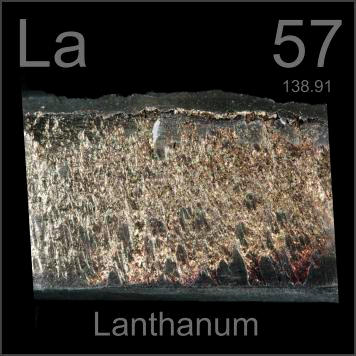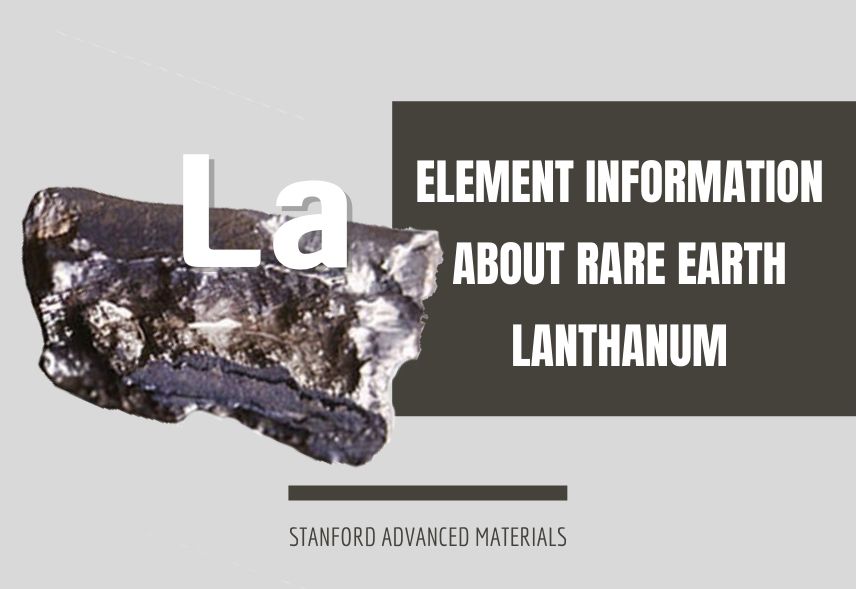Introduction
Lanthanum is a rare-earth element with a silvery-white appearance. It is represented as La and is number one on the lanthanide series. Lanthanum is described as the second most reactive element in the lanthanide series. Contrary to its classification as a rare-earth element, lanthanum is the 28th most abundant element. It is also the third most abundant rare-earth element.
Lanthanum was first discovered in 1839 by a Swedish scientist called Carl Gustaf Mosander. It was found in cerium nitrate. It was not isolated until 1923. Lanthanum is derived from the Greek word Lanthanein which means ‘to lie concealed’. This rare-earth element is not naturally found in isolation. It is usually found in minerals like bastnasite and monazite.
There are two isotopes of lanthanum that occur naturally. These two isotopes are 138La and 139La.139La is the most abundant of the two isotopes, accounting for about 99.9 % of naturally occurring Lanthanum isotopes. The other isotopes of Lanthanum that exist are radioactive. These radioisotopes have a very short half-life except 137La.

Properties
Most of the properties of lanthanum are determined by its periodicity and its atomic number. On the periodic table, it belongs to the f-block and period 6. The standard atomic weight of lanthanum is 138.9.
Lanthanum is a ductile and malleable element. It is also soft. This element is soft enough to be cut through with a knife.
At standard temperature and pressure, lanthanum is solid. However, it melts at 1193 K and evaporates when it reaches 3737 K. Also, its density is highly dependent on its state. Its density is 6.162 g/cm3 when it is solid, but it becomes 5.94 g/cm3 when it is liquid.
Lanthanum has a double hexagonal close-packed crystal structure. Compared with other rare-earth metals, lanthanum is described as having low volatility. Furthermore, at room temperature, this rare-earth element is described as being paramagnetic. Its most common oxidation state is +3.
When lanthanum is oxidized, it forms lanthanum(iii) oxide. It reacts with water to produce lanthanum hydroxide. In addition, lanthanum is soluble in dilute sulphuric acid.
Lanthanum Compounds
Lanthanum has several compounds. Each compound has characteristics peculiar to it. The characteristics of these compounds determine how they are applied.
Lanthanum Hexaboride
LaB6 is undoubtedly one of the most popular lanthanum compounds. It is used in the production of LaB6 filaments. These filaments are widely used in scanning electron microscopy, transmission electron microscopy, and x-ray beam analysis.
Lanthanum Fluoride
This compound is formed from a reaction between lanthanum and fluorine. Unlike the compounds formed between lanthanum and other heavier halides, it does not dissolve in water.
Applications
Since its discovery in 1838, lanthanum has been applied in various industries. Further research is still ongoing on just how much value lanthanum has to offer in the world today.
Gas Lantern Mantle
This is the earliest known application of lanthanum. Carl Auer von Welsbach was the first person known to have applied lanthanum to a gas lantern mantle. Carl Auer von Welsbach did not enjoy much success from this innovation. Two years after he founded it, his company was shut down in 1889.
Thin-Film Coating
Lanthanum sputtering targets and Lanthanum evaporation materials are used in deposition processes including semiconductor deposition, chemical vapor deposition (CVD) and physical vapor deposition (PVD).
Nickel-Metal Hydride Batteries
Lanthanum compounds are used in making the anode of these batteries. NiMH batteries are rechargeable and are usually used in automobiles and digital cameras. Williams and Buschow were the first scientists to use lanthanum compounds to produce nickel-metal hydride batteries. They did so in 1987.
Mischmetal
This is a composite of rare-earth elements of which lanthanum is a part. Lanthanum usually makes up 25% of mischmetal. Mischmetal is used to galvanize zinc-aluminum and to produce cigarette lighter flints. It is also used to produce rare-earth elements.
ZBLAN
ZBLAN is a fluoride glass made from zirconium, barium, lanthanum, aluminum, and sodium. ZBLAN is used to manufacture optical fibers. Optical fibers are used for communication and to transmit light over long distances.
Carbon Arc Lamps
Lanthanum is used to produce carbon arc lamps. Carbon arc lamps are not as widely used as they once were. However, they are used in making searchlights and projectors. They were also popularly used in motion pictures until they became obsolete.
Algae Removal
Lanthanum is used in some of the chemicals used to clean swimming pools. This is because lanthanum removes the phosphate present in the pool. The absence of phosphate in the pool makes it difficult for algae to thrive.
Hyperphosphatemia
Hyperphosphatemia is a condition in which there is an excess of sodium ions in the blood. Lanthanum is added to some drugs used to treat this condition because it can remove the phosphate ions.
Conclusion
Lanthanum can be described as the blueprint element of the lanthanide series. It is the first element in the series. It is from this element that the series derives its name. Various lanthanum compounds such as LaCl3, LaB6, and La(OH)3 are applied in many industries. If you want to know more about rare earth elements, we would like to advise you to visit Stanford Advanced Materials (SAM) for more information.





